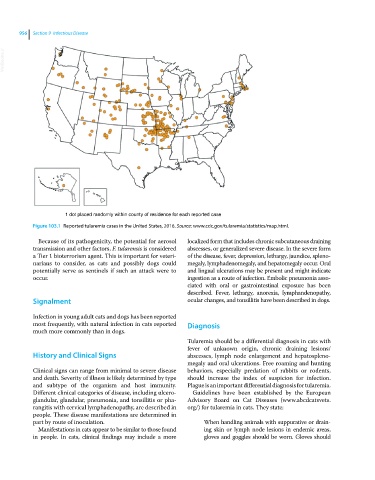Page 1018 - Clinical Small Animal Internal Medicine
P. 1018
956 Section 9 Infectious Disease
VetBooks.ir
1 dot placed randomly within county of residence for each reported case
Figure 103.1 Reported tularemia cases in the United States, 2016. Source: www.cdc.gov/tularemia/statistics/map.html.
Because of its pathogenicity, the potential for aerosol localized form that includes chronic subcutaneous draining
transmission and other factors, F. tularensis is considered abscesses, or generalized severe disease. In the severe form
a Tier 1 bioterrorism agent. This is important for veteri- of the disease, fever, depression, lethargy, jaundice, spleno-
narians to consider, as cats and possibly dogs could megaly, lymphadenomegaly, and hepatomegaly occur. Oral
potentially serve as sentinels if such an attack were to and lingual ulcerations may be present and might indicate
occur. ingestion as a route of infection. Embolic pneumonia asso-
ciated with oral or gastrointestinal exposure has been
described. Fever, lethargy, anorexia, lymphandenopathy,
Signalment ocular changes, and tonsillitis have been described in dogs.
Infection in young adult cats and dogs has been reported
most frequently, with natural infection in cats reported Diagnosis
much more commonly than in dogs.
Tularemia should be a differential diagnosis in cats with
fever of unknown origin, chronic draining lesions/
History and Clinical Signs abscesses, lymph node enlargement and hepatospleno-
megaly and oral ulcerations. Free roaming and hunting
Clinical signs can range from minimal to severe disease behaviors, especially predation of rabbits or rodents,
and death. Severity of illness is likely determined by type should increase the index of suspicion for infection.
and subtype of the organism and host immunity. Plague is an important differential diagnosis for tularemia.
Different clinical categories of disease, including ulcero- Guidelines have been established by the European
glandular, glandular, pneumonia, and tonsillitis or pha- Advisory Board on Cat Diseases (www.abcdcatsvets.
rangitis with cervical lymphadenopathy, are described in org/) for tularemia in cats. They state:
people. These disease manifestations are determined in
part by route of inoculation. When handling animals with suppurative or drain-
Manifestations in cats appear to be similar to those found ing skin or lymph node lesions in endemic areas,
in people. In cats, clinical findings may include a more gloves and goggles should be worn. Gloves should

